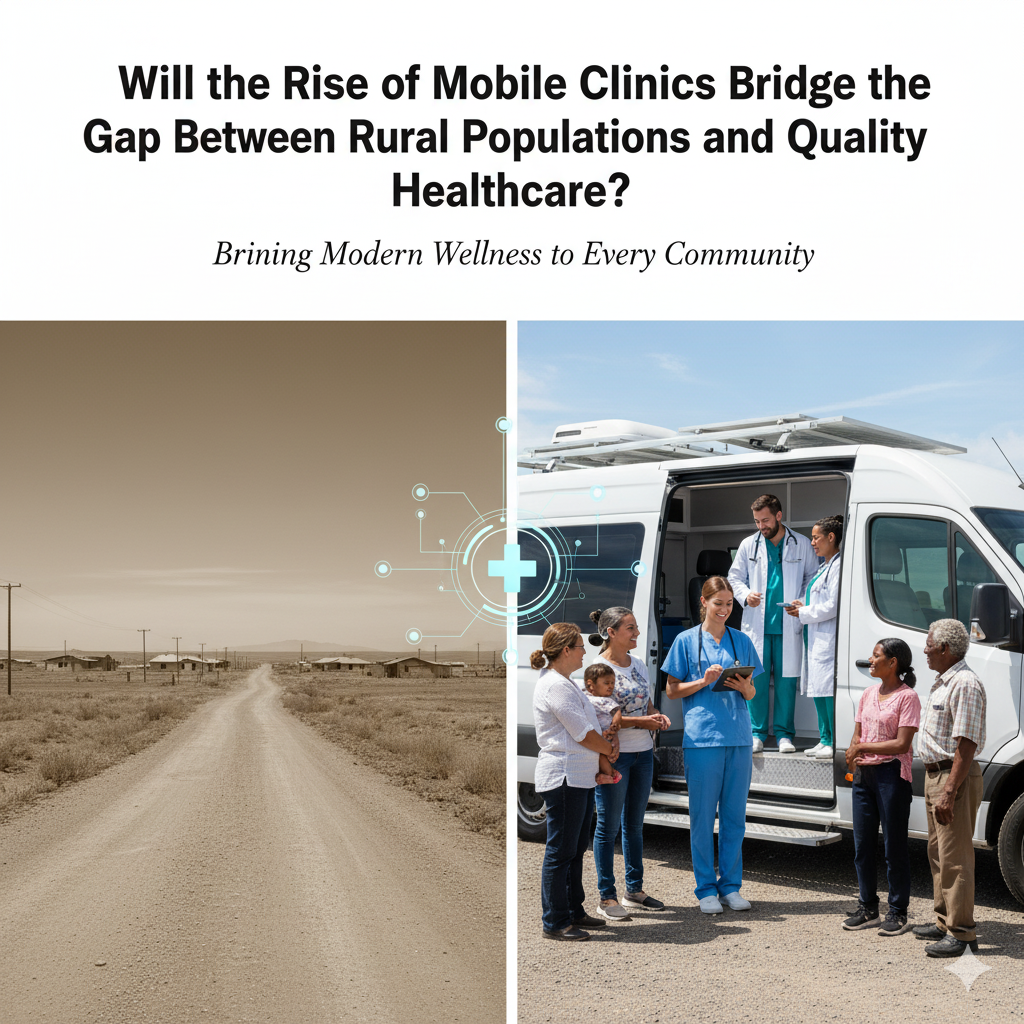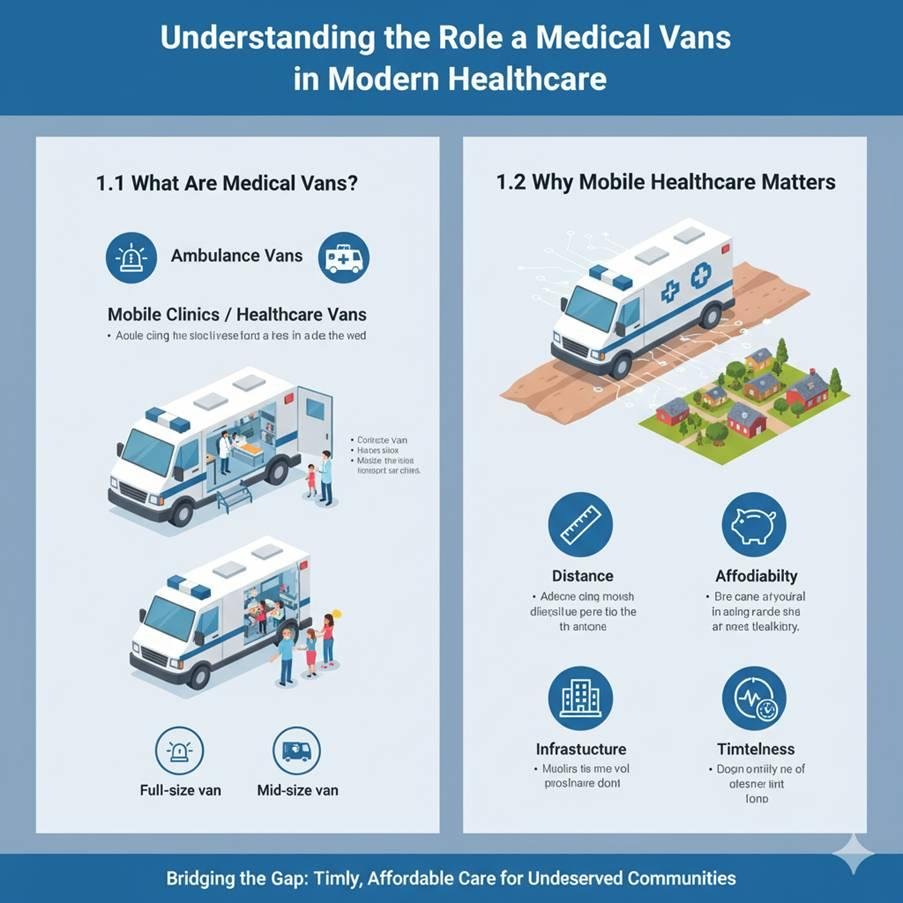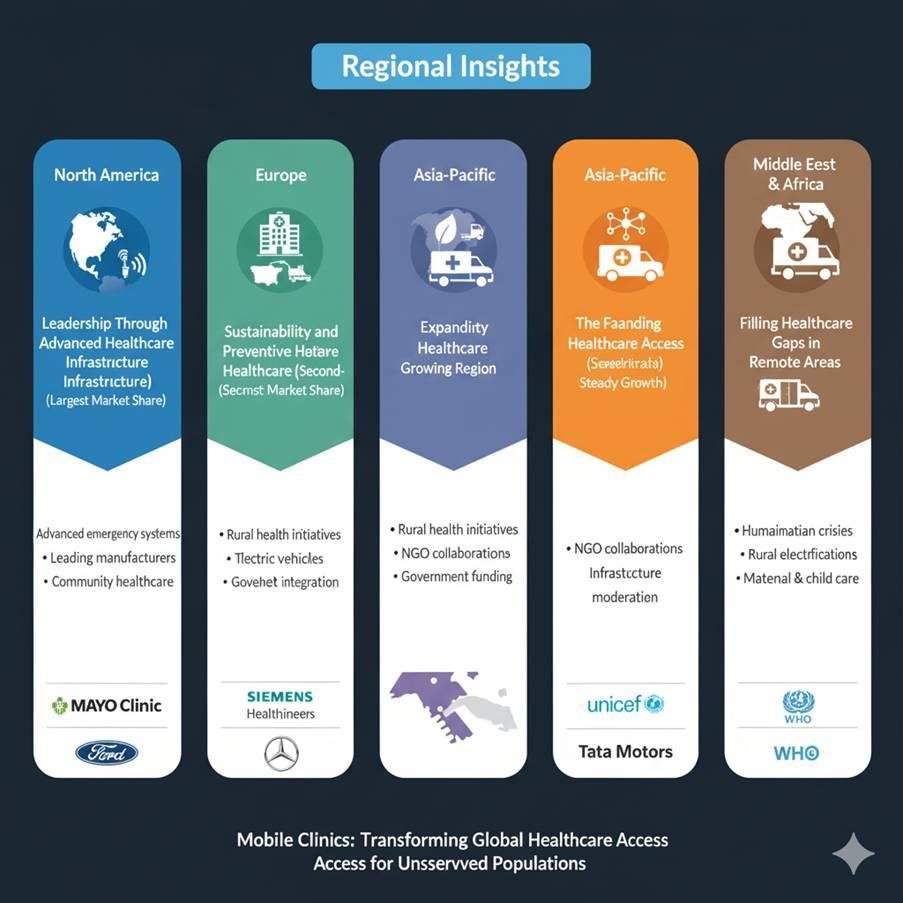Will the Rise of Mobile Clinics Bridge the Gap Between Rural Populations and Quality Healthcare?

Will the Rise of Mobile Clinics Bridge the Gap Between Rural Populations and Quality Healthcare?
Introduction
Healthcare accessibility remains one of the most pressing global challenges of the 21st century. Despite tremendous advancements in medical technology and infrastructure, millions of people in rural and underserved regions still lack access to timely and quality healthcare. Limited hospital facilities, shortages of trained professionals, and geographical isolation create a widening gap in public health delivery.
In this landscape, mobile medical vans—often referred to as mobile clinics or healthcare-on-wheels—have emerged as a transformative solution. By combining mobility, technology, and preventive healthcare, these units deliver essential medical services directly to the people who need them most. From vaccination drives and maternal care to chronic disease management and teleconsultations, medical vans represent a new model of equitable healthcare delivery.
According to Credence research, the Medical Van Market, valued at USD 11.3 billion in 2024, is projected to reach USD 19.9 billion by 2032, expanding at a CAGR of 7.3%. The growth is fueled by the demand for accessible healthcare, telemedicine integration, and government-driven public health programs.
This article explores, step by step, how the rise of mobile clinics is bridging the rural healthcare gap—driven by innovation, policy support, and sustainability efforts—and what this means for the future of global healthcare systems.
Source: Medical Van Market Size, Growth, Share and Forecast 2032
1. Understanding the Role of Medical Vans in Modern Healthcare

Figure 2: Infographic explaining medical vans, including their types (Ambulance, Mobile Clinics), sizes, and importance in addressing healthcare barriers like distance, affordability, and infrastructure in remote areas.
1.1 What Are Medical Vans?
Medical vans are specially equipped vehicles designed to deliver healthcare services outside traditional hospital settings. These include:
- Ambulance Vans – For emergency medical response and patient transportation.
- Mobile Clinics / Healthcare Vans – Equipped with diagnostic, treatment, and consultation tools for general and specialized medical care.
Depending on their size and purpose, medical vans can be:
- Full-size vans – For full-scale mobile clinics or diagnostic units.
- Mid-size vans – For rural health outreach, vaccination programs, or basic check-ups.
1.2 Why Mobile Healthcare Matters
Mobile medical vans provide continuity of care in regions lacking hospitals, connecting urban medical expertise with remote populations. They also serve as first-line responders during epidemics, natural disasters, and humanitarian crises.
These units address key barriers:
- Distance: Bringing healthcare to remote villages.
- Affordability: Offering low-cost or subsidized medical services.
- Infrastructure: Reducing dependence on stationary clinics.
- Timeliness: Delivering immediate care during emergencies or outbreaks.
2. Market Drivers: What’s Powering the Growth of Medical Vans
2.1 Rising Demand for Accessible Rural Healthcare
A major growth driver is the expanding global effort to deliver healthcare to underserved populations. In rural areas of Asia, Africa, and Latin America, mobile vans act as mobile hospitals, offering diagnostic, maternal, and child health services where permanent facilities are absent.
Governments, NGOs, and private healthcare providers deploy medical vans to conduct:
- Vaccination campaigns
- Health awareness programs
- Chronic disease management (diabetes, hypertension)
- Maternal and child health check-ups
These services significantly reduce travel time for patients and ensure early disease detection, improving public health outcomes.
2.2 Technological Integration: Telemedicine and Digital Diagnostics
Modern medical vans are no longer simple vehicles—they are smart, connected healthcare platforms. Key advancements include:
- Telemedicine systems for real-time video consultations with specialists.
- Portable diagnostic equipment, such as ECGs, ultrasound machines, and blood analyzers.
- Cloud-based health records for seamless patient tracking and continuity of care.
- IoT-enabled monitoring systems that enhance diagnostic accuracy.
Such integration allows virtual healthcare extension into rural areas without requiring full-scale hospital infrastructure. This combination of mobility and connectivity is reshaping global healthcare ecosystems.
2.3 Government and NGO-Driven Healthcare Programs
Public health initiatives play a critical role in the widespread adoption of medical vans.
Examples include:
- India’s Ayushman Bharat Program, deploying thousands of mobile medical units in rural and tribal regions.
- WHO and Red Cross mobile clinics, offering health services in disaster zones and low-resource countries.
- U.S. and European mobile health programs, targeting marginalized communities, migrants, and homeless populations.
These programs ensure that primary healthcare becomes universal and equitable, regardless of geography.
2.4 The Sustainability Imperative: Electric and Hybrid Vans
As global awareness of climate change rises, healthcare organizations are embracing eco-friendly mobile clinics. Electric and hybrid vans not only reduce carbon emissions but also cut fuel and maintenance costs, ensuring long-term operational efficiency.
Manufacturers are responding by designing:
- Electric-powered ambulance vans with renewable charging solutions.
- Solar-assisted medical vehicles for off-grid areas.
- Hybrid vans optimized for both urban and rural terrains.
This aligns with the global green healthcare movement, emphasizing environmental and social responsibility in healthcare delivery.
2.5 Private Investment and Innovation
Growing private investment is transforming the industry landscape.
Companies like EcoLife Medical Systems, Ford Mobility Healthcare, and Winnebago Specialty Vehicles are introducing customized, modular, and sustainable designs tailored for public health agencies and NGOs.
Investors see mobile healthcare as a high-impact, high-return sector, combining social welfare with market profitability.
3. Market Restraints and Challenges
Despite rapid expansion, the medical van industry faces several challenges:
3.1 High Operational and Maintenance Costs
Equipping a van with advanced medical devices, refrigeration units (for vaccines), and telecommunication systems significantly raises costs. Maintenance, fuel, and staffing further add to operational expenses.
3.2 Infrastructure and Workforce Gaps
In developing countries, shortages of trained healthcare professionals limit the reach and effectiveness of mobile clinics. Moreover, poor road infrastructure and unreliable power supply affect regular operations.
3.3 Regulatory and Licensing Barriers
Different regions have inconsistent regulations for mobile medical units, particularly regarding:
- Licensing and certification of healthcare staff.
- Sterilization and equipment standards.
- Data privacy in telemedicine operations.
These inconsistencies can slow cross-border expansion and limit service efficiency.
4. Market Segmentation Overview
4.1 By Van Type
- Ambulance Vans: Focused on emergency response and patient transfer.
- Mobile Clinics / Healthcare Vans: Equipped for diagnosis, treatment, and teleconsultation.
4.2 By Vehicle Size
- Full-Size Vans: Offer more space for specialized care and multiple staff.
- Mid-Size Vans: Favored for rural access and preventive care drives due to easy maneuverability.
4.3 By Application
- Emergency Medical Services (EMS): Providing urgent care and patient transportation.
- Non-Emergency Medical Transportation (NEMT): Supporting regular check-ups, chronic disease monitoring, and preventive programs.
5. Regional Insights

Figure 3: Image illustrating the regional insights for the Medical Van Market, showing North America leading with advanced infrastructure, Europe focusing on sustainability and preventive care, and Asia-Pacific as the fastest-growing region due to rural health i
5.1 North America: Leadership Through Advanced Healthcare Infrastructure
North America dominates the market with the largest share, driven by:
- Advanced emergency response systems and integrated telemedicine networks.
- Strong presence of leading manufacturers and custom medical van builders.
- High investment in mobile emergency services and community healthcare.
The United States leads in innovation, with hospitals deploying AI-powered mobile diagnostics and electric ambulances. Canada focuses on rural outreach and Indigenous healthcare access programs.
5.2 Europe: Sustainability and Preventive Healthcare Focus
Europe holds the second-largest market share, supported by:
- A growing emphasis on preventive healthcare and elderly care mobility programs.
- Strict sustainability policies promoting electric and low-emission vehicles.
- Public-private partnerships that encourage telehealth-integrated mobile units.
Countries such as Germany, France, and the UK are pioneers in deploying smart medical vans for chronic disease monitoring and vaccination campaigns.
5.3 Asia-Pacific: The Fastest-Growing Region
Asia-Pacific is the fastest-growing market, driven by:
- Expanding rural health initiatives in India and China.
- Technological leadership from Japan and South Korea, introducing compact, digitally equipped vans.
- Rising government funding for mobile healthcare outreach in developing nations.
Programs under India’s National Health Mission (NHM) and China’s rural medical reform highlight how mobile units are closing healthcare gaps for millions.
5.4 Latin America: Expanding Healthcare Access
In Latin America, growth is steady but promising.
Countries like Brazil, Mexico, and Chile are deploying medical vans to reach remote communities, with increasing collaboration between public health ministries and NGOs. Infrastructure modernization and renewable integration further support adoption.
5.5 Middle East & Africa: Filling Healthcare Gaps in Remote Areas
The Middle East and Africa regions are using medical vans to serve areas with limited hospital access, especially during humanitarian crises and refugee health operations.
- UAE and Saudi Arabia focus on smart healthcare mobility.
- African nations leverage donor-supported programs to deliver maternal and child care services in rural districts.
6. Competitive Landscape
6.1 Key Players and Strategies
The global market features a mix of automotive manufacturers, healthcare solution providers, and specialty vehicle firms.
|
Company |
Focus Area |
Strategic Highlights |
|
Winnebago Specialty Vehicles |
Custom mobile clinics |
Modular designs for U.S. healthcare networks |
|
Ford Mobility Healthcare |
Electric medical vans |
Integration of telemedicine tools |
|
LDV Healthcare Vans |
European markets |
Focus on compact, eco-friendly models |
|
Chint Global & AceOn Group |
Renewable-linked units |
Solar and hybrid medical vans |
|
ATGepower & EcoLife Systems |
Asia-Pacific markets |
Affordable solutions for rural programs |
Manufacturers are prioritizing innovation in design, safety, and sustainability, enabling vans to function as mobile hospitals or diagnostic hubs.
6.2 Modular and Customizable Designs
Modern medical vans are highly adaptable.
They can be reconfigured for different purposes, including:
- Dental and vision care
- Blood donation drives
- Mobile laboratories
- Maternal and pediatric clinics
This modularity allows governments and NGOs to maximize van utilization and minimize costs.
7. Technology Trends Reshaping the Market
7.1 Telemedicine Integration
The fusion of real-time video consultations and cloud-based medical records allows specialists from urban centers to diagnose and monitor patients in remote areas instantly.
7.2 Portable and Smart Diagnostic Devices
Compact, battery-operated diagnostic tools—such as point-of-care testing kits, portable X-rays, and digital stethoscopes—enhance mobility without sacrificing accuracy.
7.3 AI and Data Analytics
AI-driven tools support:
- Predictive health analytics for epidemic monitoring.
- Route optimization for mobile van deployment.
- Real-time equipment maintenance alerts.
7.4 Sustainability Technologies
Emerging focus on solar charging, electric drivetrains, and energy-efficient refrigeration units aligns the market with environmental goals.
8. Market Outlook (2024–2032)
|
Year |
Market Value (USD Billion) |
CAGR |
|
2024 |
11.3 |
— |
|
2027 |
14.5 |
— |
|
2030 |
17.3 |
— |
|
2032 |
19.9 |
7.3% |
The steady growth trajectory is driven by:
- Government investment in healthcare infrastructure.
- Increasing disaster preparedness and outreach programs.
- Private sector innovation and public-private partnerships.
The next decade will see AI-integrated, zero-emission mobile clinics as a standard part of national healthcare systems.
9. Societal and Economic Impact
The rise of medical vans creates multidimensional benefits:
- Improved health equity: Bringing care to people who need it most.
- Economic efficiency: Reducing hospital crowding and healthcare costs.
- Job creation: Generating employment for healthcare workers and technicians.
- Environmental gains: Through electric and hybrid fleet adoption.
Moreover, mobile clinics empower women’s healthcare, chronic disease prevention, and health education, shaping healthier, more resilient communities.
Conclusion
So, will the rise of mobile clinics bridge the gap between rural populations and quality healthcare?
The answer is a resounding yes—but with ongoing commitment and innovation.
Medical vans have become the backbone of accessible healthcare, ensuring that geography no longer dictates health outcomes. As governments, NGOs, and private companies unite under a shared goal of universal healthcare access, mobile clinics represent not just vehicles, but vessels of hope—delivering life-saving care, dignity, and equality to communities everywhere.
With advancing technology, sustainability initiatives, and policy support, the medical van market is not only expanding—it’s redefining the very structure of modern healthcare delivery.
Source: Medical Van Market Size, Growth, Share and Forecast 2032

- Business
- Research
- Energy
- Art
- Causes
- Tech
- Crafts
- crypto
- Dance
- Drinks
- Film
- Fitness
- Food
- Oyunlar
- Gardening
- Health
- Home
- Literature
- Music
- Networking
- Other
- Party
- Religion
- Shopping
- Sports
- Theater
- Wellness


